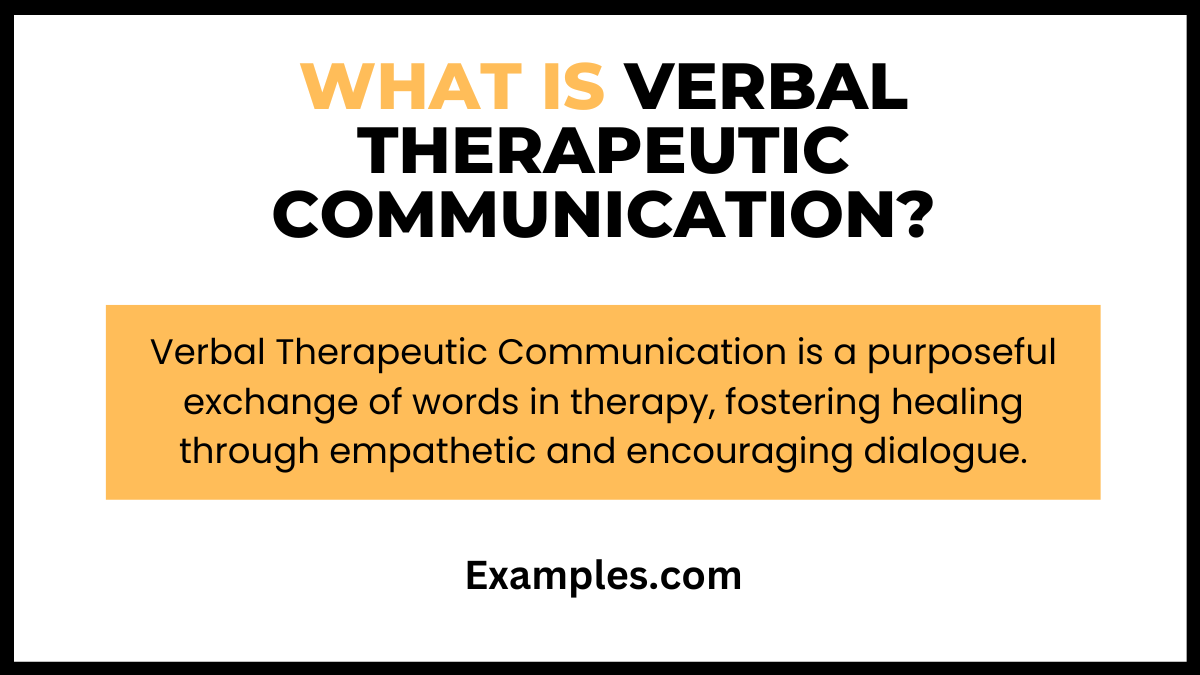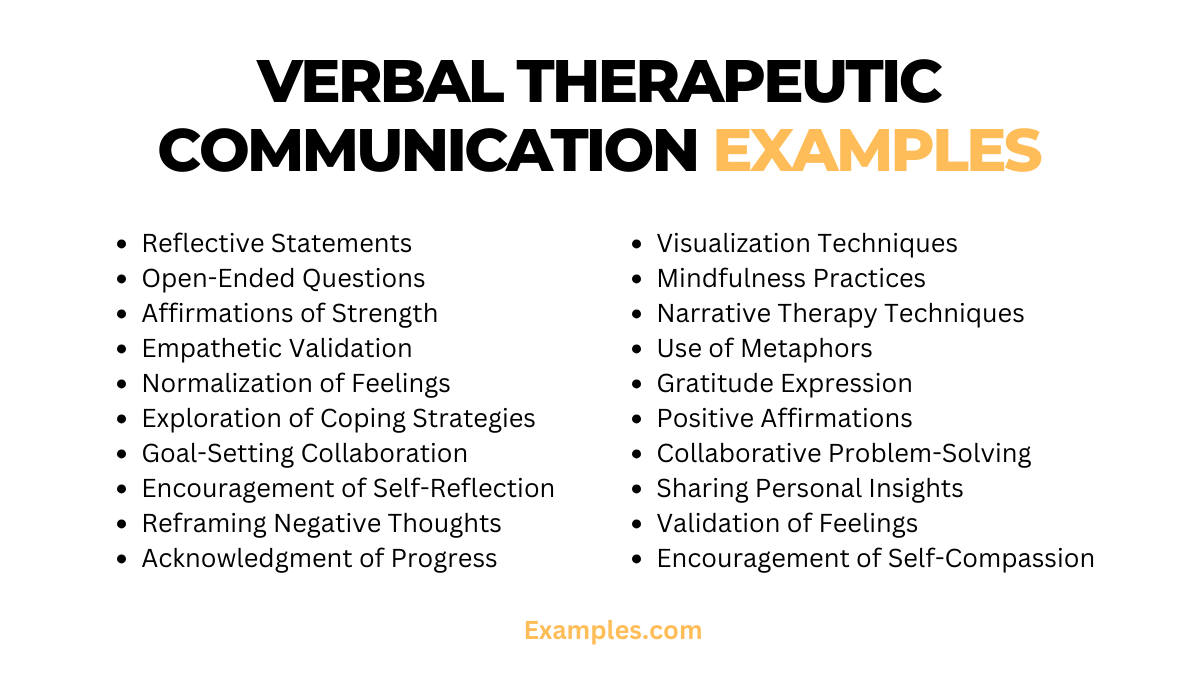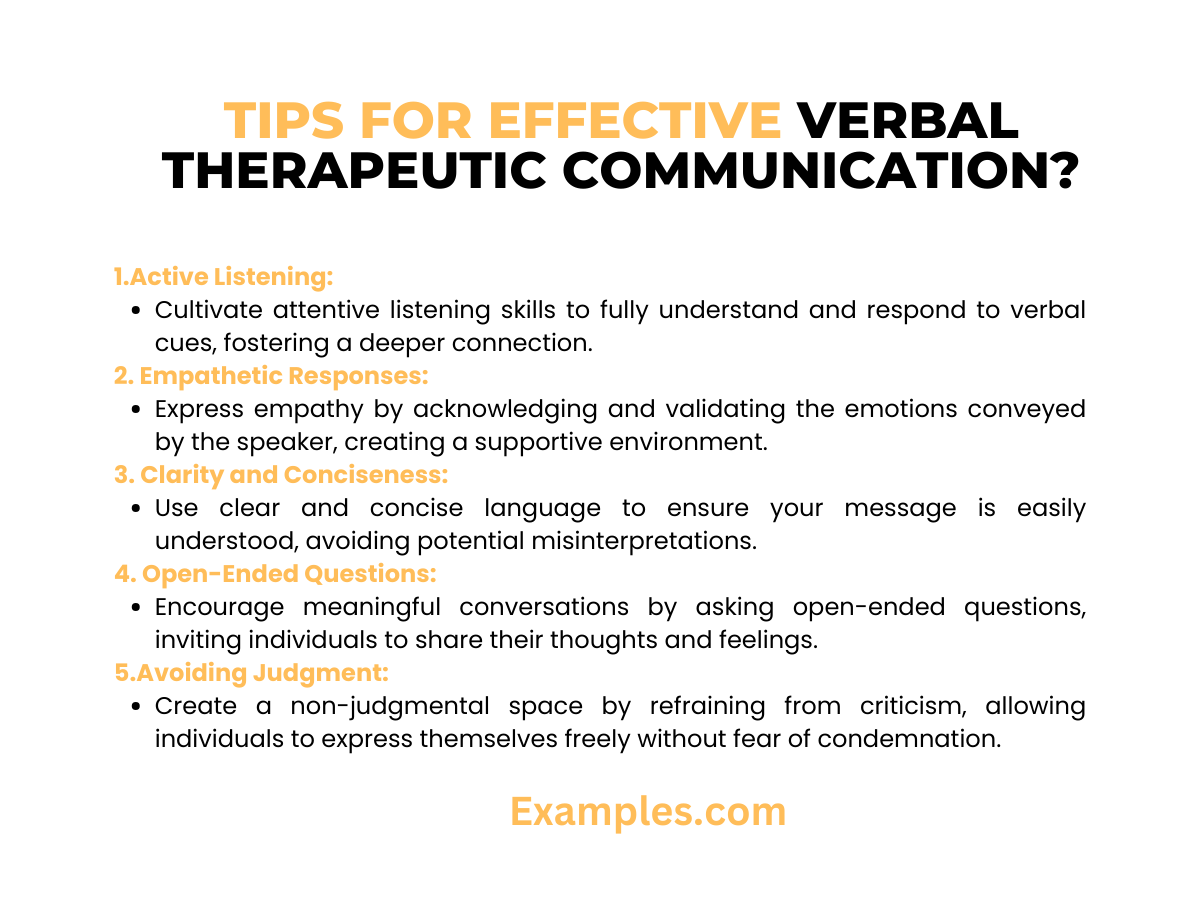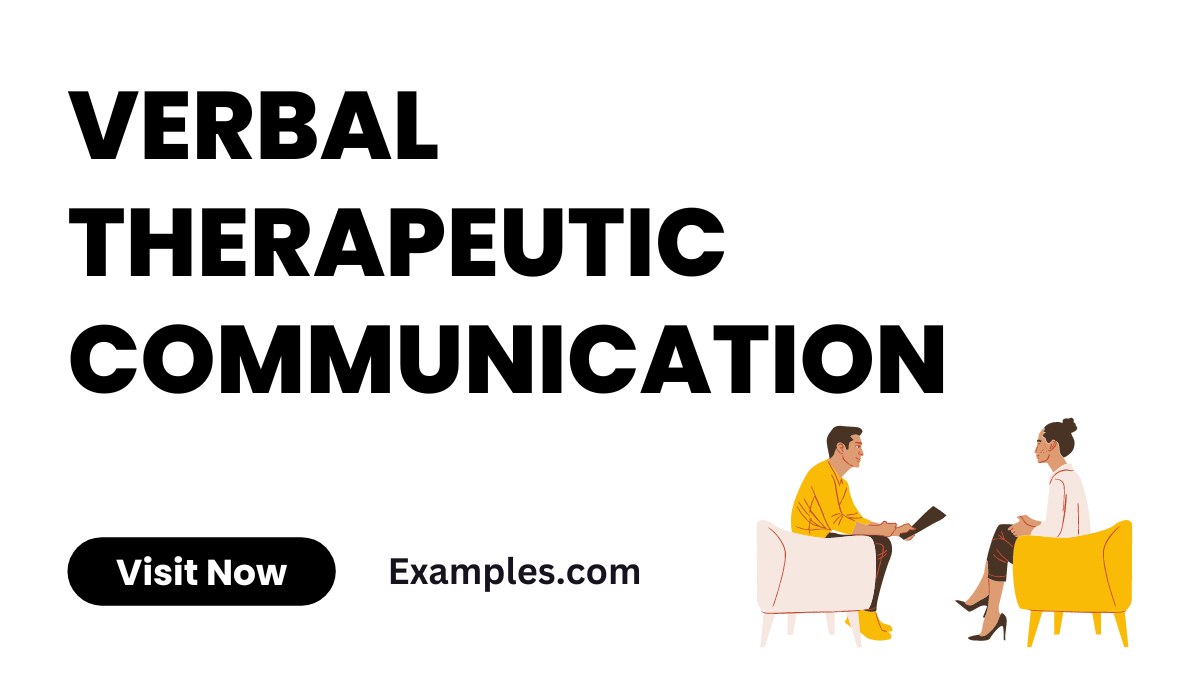19+ Verbal Therapeutic Communication Examples
Embark on a transformative journey into Verbal Therapeutic Communication, where spoken words become powerful tools for connection and healing. This comprehensive guide unveils the intricacies of verbal communication in therapeutic settings, providing vivid examples that underscore the significance of every uttered phrase. Explore techniques, strategies, and real-world Communication Examples that elevate the healing process through thoughtful and impactful verbal exchanges. Enhance your therapeutic communication skills by delving into the art of effective verbal expression.
What is Verbal Therapeutic Communication?

Verbal Therapeutic Communication is a method of exchanging words with the aim of fostering healing, understanding, and support in therapeutic settings. It involves purposeful verbal interactions, where the spoken language becomes a conduit for empathy, encouragement, and building rapport. This form of communication relies on the skillful use of words to convey compassion and aid in the emotional well-being of individuals. In the context of therapy, practitioners employ Verbal Therapeutic Communication to facilitate meaningful dialogues that contribute to the overall healing process.
20 Verbal Therapeutic Communication Examples
 In therapeutic settings, Verbal Therapeutic Communication is a powerful tool for fostering understanding and emotional well-being. Explore these impactful examples to guide and inspire your own communication strategies.
In therapeutic settings, Verbal Therapeutic Communication is a powerful tool for fostering understanding and emotional well-being. Explore these impactful examples to guide and inspire your own communication strategies.
- Reflective Statements:
Example: “I hear your concerns; it sounds like you’re navigating a challenging situation. How can I support you?” - Open-Ended Questions:
Example: “What thoughts come to mind when you reflect on your experiences? Share as much or as little as you’re comfortable with.” - Affirmations of Strength:
Example: “You’ve demonstrated remarkable resilience in facing adversity. Acknowledge your strength and progress.” - Empathetic Validation:
Example: “It’s entirely understandable to feel that way given the circumstances. Your emotions are valid, and I’m here to listen.” - Normalization of Feelings:
Example: “Many individuals in similar situations have experienced similar emotions. You’re not alone in feeling this way.” - Exploration of Coping Strategies:
Example: “Let’s explore healthy coping mechanisms together. What activities bring you a sense of calm and peace?” - Goal-Setting Collaboration:
Example: “What achievable goals would you like to work towards? Let’s create a plan that aligns with your aspirations.” - Encouragement of Self-Reflection:
Example: “Take a moment to reflect on your progress. Recognize the positive steps you’ve taken toward your goals.” - Reframing Negative Thoughts:
Example: “How might we reframe this negative thought into a more positive and constructive perspective?” - Acknowledgment of Progress:
Example: “Celebrate the small victories on your journey. Each step forward is a commendable achievement.” - Visualization Techniques:
Example: “Imagine a safe and serene place. Describe the details; let this visualization bring tranquility.” - Mindfulness Practices:
Example: “Let’s engage in a brief mindfulness exercise together. Focus on your breath and the present moment.” - Narrative Therapy Techniques:
Example: “Share your story in a way that empowers you. How would you like this chapter to unfold?” - Use of Metaphors:
Example: “Think of your journey as a river. Embrace the flow, navigate obstacles, and trust in your resilience.” - Gratitude Expression:
Example: “Express gratitude for moments of joy, no matter how small. What brought a smile to your face recently?” - Positive Affirmations:
Example: “Repeat positive affirmations daily. Affirm your worth, resilience, and capacity for growth.” - Collaborative Problem-Solving:
Example: “Let’s work together to identify solutions. Your insights are valuable in finding effective paths forward.” - Sharing Personal Insights:
Example: “I appreciate your willingness to share. Your insights contribute to a deeper understanding of your journey.” - Validation of Feelings:
Example: “It’s completely normal to feel a range of emotions. Your feelings are valid and worthy of acknowledgment.” - Encouragement of Self-Compassion:
Example: “Extend the same compassion to yourself that you offer to others. Embrace self-kindness on your journey.”
Verbal Therapeutic Communication Examples in Nursing
In the nursing profession, Verbal Therapeutic Communication is a cornerstone for compassionate care. Explore how nuanced communication techniques in nursing settings foster understanding and strengthen patient connections.
- Empathy in Critical Moments:
Example: In critical situations, empathetic communication provides solace. “I can imagine this is frightening. We’re here to support you.” - Encouraging Shared Decision-Making:
Example: “Your insights matter in decision-making. What are your thoughts on the proposed treatment plan?” - Effective Pain Management Discussion:
Example: Addressing pain with empathy: “Let’s discuss your pain levels, ensuring we tailor our approach to enhance your comfort.” - Supportive Tone during Challenges:
Example: “Facing health challenges is tough. I’m here to support you through the ups and downs of your healthcare journey.” - Personalized Care Acknowledgment:
Example: “Your uniqueness shapes our care approach. Let’s tailor a plan that aligns with your individual needs.” - Open Communication about Progress:
Example: “Sharing your progress is essential. It helps us celebrate achievements and adapt our approach for continued success.” - Clarifying Medication Understanding:
Example: “Understanding your medications is crucial. Let’s review them together to ensure clarity and adherence.” - Acknowledging Patient Contributions:
Example: “Your insights contribute to our care strategy. How would you like to actively participate in your healthcare decisions?” - Empowerment in Rehabilitation:
Example: “Rehabilitation is a journey. Your active involvement empowers you to regain control and achieve your health goals.” - Navigating Emotional Discussions:
Example: “Emotional discussions are welcomed. Your feelings and concerns are important elements guiding our care approach.”
Verbal Therapeutic Communication Examples in Healthcare
Enhancing patient outcomes through compassionate communication is paramount in healthcare. Explore nuanced Verbal Therapeutic Communication examples tailored to healthcare settings, fostering trust, and promoting positive experiences.
In healthcare, effective communication is not just a tool; it’s a cornerstone for patient-centered care. Discover how verbal therapeutic communication in healthcare settings contributes to positive patient experiences and improved well-being.
- Empathetic Acknowledgment of Fear:
Example: “Facing surgery can be daunting. Your fear is valid, and we’re here to support you through the process.” - Affirming Patient Strengths:
Example: “Your resilience is admirable. Recognizing your strengths is integral to navigating your healthcare journey.” - Open-Ended Questions for Understanding:
Example: “Tell me more about how you’ve been feeling. Your insights guide our approach to personalized care.” - Reassurance in Uncertain Times:
Example: “Uncertainty can be unsettling. We’re committed to providing information and support to ease your concerns.” - Promoting Autonomy in Decision-Making:
Example: “Your choices matter. Let’s discuss options and decide together on the best course for your care.” - Encouraging Expression of Concerns:
Example: “It’s crucial to share any concerns you may have. Your input guides us in providing comprehensive and tailored care.” - Validation of Emotional Responses:
Example: “It’s okay to feel overwhelmed. Validating your emotions allows us to address them and work towards your emotional well-being.” - Celebrating Milestones in Recovery:
Example: “Reaching this milestone in your recovery is commendable. Let’s acknowledge and build on these positive steps together.” - Clarity in Treatment Plan Communication:
Example: “Understanding your treatment plan is essential. I’ll ensure clear communication to empower you in making informed decisions.” - Empowering Through Health Education:
Example: “Knowledge is empowering. Let’s delve into the details of your condition, ensuring you’re well-informed about your health journey.”
What are the Techniques for Verbal Therapeutic Communication?
Verbal therapeutic communication is a cornerstone in healthcare, fostering meaningful interactions between healthcare professionals and patients. Explore effective techniques that contribute to positive patient outcomes and create a supportive environment.
- Active Listening: Engage fully with patients, showing empathy through attentive listening. Reflecting on their words demonstrates understanding and promotes trust.
- Empathetic Responses: Responding with empathy validates patients’ emotions, fostering a sense of understanding and connection essential for therapeutic outcomes.
- Open-Ended Questions: Encourage patients to share their thoughts and feelings by using questions that prompt detailed responses, providing valuable insights into their well-being.
- Reflective Responses: Mirror patients’ emotions, allowing them to feel heard and understood. Reflective responses enhance rapport and strengthen the therapeutic alliance.
- Clarification Techniques: Ensure clear communication by using clarification methods to address any confusion or uncertainty, promoting accurate information exchange.
What are the Verbal and Nonverbal Therapeutic Use?
The combined use of verbal and nonverbal communication is integral to holistic healthcare interactions. Explore how these two forms of communication synergize to create comprehensive, patient-centered care.
- Synchronizing Verbal and Nonverbal Cues: Align verbal expressions with nonverbal cues, promoting coherence and reinforcing the intended message for enhanced understanding.
- Nonverbal Empathy Expression: Complement verbal empathy with nonverbal expressions such as facial gestures and body language, reinforcing a genuine connection with patients.
- Adaptability in Communication Styles: Recognize individual patient preferences by adapting both verbal and nonverbal communication styles to create a personalized and comfortable interaction.
- Consistency in Messaging: Ensure consistency between verbal instructions and nonverbal signals, minimizing confusion and reinforcing trust in healthcare interactions.
- Cultural Sensitivity in Nonverbal Communication: Respect cultural differences in nonverbal communication, recognizing that gestures and expressions may vary, ensuring inclusivity and understanding.
Tips for Effective Verbal Therapeutic Communication?

Verbal therapeutic communication is a vital skill in fostering positive interactions in various settings. Follow these tips to enhance your ability to communicate effectively and empathetically:
- Active Listening: Cultivate attentive listening skills to fully understand and respond to verbal cues, fostering a deeper connection.
- Empathetic Responses: Express empathy by acknowledging and validating the emotions conveyed by the speaker, creating a supportive environment.
- Clarity and Conciseness: Use clear and concise language to ensure your message is easily understood, avoiding potential misinterpretations.
- Open-Ended Questions: Encourage meaningful conversations by asking open-ended questions, inviting individuals to share their thoughts and feelings.
- Avoiding Judgment: Create a non-judgmental space by refraining from criticism, allowing individuals to express themselves freely without fear of condemnation.
- Positive Reinforcement: Offer positive feedback and reinforcement to reinforce constructive behaviors and encourage a positive therapeutic relationship.
- Understanding Cultural Sensitivity: Be aware of cultural differences, respecting diverse perspectives to ensure communication is culturally sensitive and inclusive.
- Respecting Personal Space: Acknowledge and respect personal space boundaries, promoting a sense of comfort and safety during verbal exchanges.
- Using Encouragers: Employ verbal encouragers, such as affirmations and supportive statements, to foster a positive and uplifting communication atmosphere.
- Tailoring Communication Styles: Adapt your communication style to match the individual’s preferences, ensuring a more personalized and effective therapeutic interaction.
In conclusion, Verbal Therapeutic Communication is the cornerstone of compassionate healing dialogues, utilizing purposeful words to foster understanding and support. This guide provides insights into effective techniques, emphasizing empathy and positive reinforcement. By mastering verbal communication skills, individuals can create meaningful connections, contributing to the overall well-being of those engaged in therapeutic settings.



